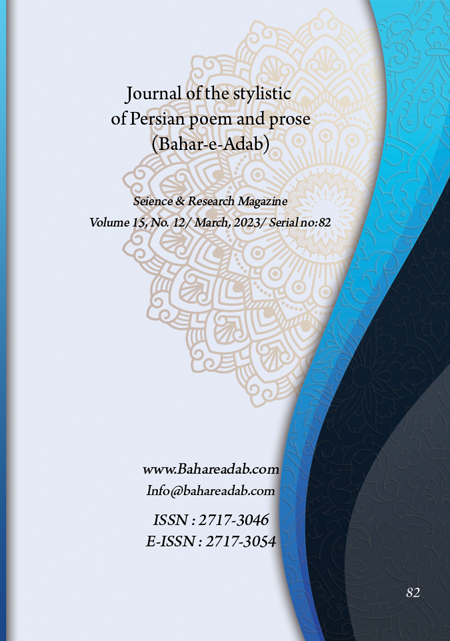- Count View : 371
- آدرس کوتاه شده مقاله: https://bahareadab.com/article_id/1414
- کد doi مقاله: Doi: 10.22034/bahareadab.2023 .15 .6809
Journal of the stylistic of Persian poem and prose
volume Number 15،
number In Volume 12،
،
issue Number 82
Stylistic features of the first volume of Darab Hormozd narrations, based on the manuscript of the Majlis library
Maryam Ghaffari Jahed , Ali Tasnimi (Author in Charge), Ebrahim Estaji , Ahmad Khajehim
Abstract
BACKGROUND AND OBJECTIVES: Zoroastrian narrations, which contain jurisprudential and legal issues of Zoroastrian religion, have been collected over the years by various narrators from India and Iran and have been compiled in a collection called Zoroastrian narrations or Darab Hormozd narrations. Several copies of this book are available in Indian and Iranian libraries. In this research, the version of the parliament library has been studied in terms of structural, intellectual and literary features.
METHODOLOGY: This descriptive-analytical study was conducted to identify the characteristics of the book and the effect of Avestan, Pahlavi, Persian and Arabic scripts and languages on its language and writing, as well as the content of narrations and its literary style.
FINDINGS: The script and language of this book are slightly influenced by the script, language and style of the tenth century and the use of Arabic words and more inclined to the script and language of Pahlavi and Avestan and Zoroastrian words. In terms of calligraphy, it prevails with continuous writing, and in terms of the use of words, Old Persian and Zoroastrian words and the Avestan language prevail, and in many cases, the Avestan script and language have been used directly in it. The handwriting of the book is also different in different places and in some pages it is ugly and irregular, which shows multiple scribes and adding content at different times. The content of the book also includes the doctrinal issues of the Zoroastrian religion, which has been quoted from authentic books through questions and answers and attention to the narrations of different narrators. From a literary point of view, no specific style can be considered for this book because It has no aesthetic basis and its features include syntactic shifts and deletion of verbs as well as repetition, a bit of simile and allegory. Poetic narrations do not have poetic features and do not have an aesthetic and original structure.
CONCLUSION: This book has different scripts and languages due to the use of different narrations from different sources and quoting various narrators, and the writing is not uniform, and its most important feature is the style of thought that expresses many dimensions of Zoroastrian religion in different languages.
Keyword
Darab Hormozd
, Zoroastrian
, calligraphy
, Avesta
, Pahlavi
, jurisprudence and law narrations
, Literary and linguistic style
- A collection of histories and stories. (1939). edited by the Queen of Spring Poets, Tehran: Khavar Printing House.
- Amoozgar, Jaleh. (1996). Pahlavi language: literature and its grammar, in collaboration with Ahmad Tafazli, Tehran: Moein.
- Ansari, Bahman. (2017). Zoroastrians and Zoroastrians, Tehran: Arun.
- Ardavirafnameh. (2003). Translation and correction of Jaleh Amoozgar, Tehran: Moein.
- Bart, Roland. (2013). Empire of Signs, translated by Nasser Fakuhi, Tehran: Nashr-e Ney.
- Bondahesh. (N.D). Print a photo from the No. 1 edition of Tahmours Dinshah, Tehran: Iranian Culture Foundation.
- Carnival of Ardeshir Babakan. (1975). Translated by Bahram Farahvashi, Tehran: University of Tehran Press.
- Dalvand, Hamidreza. (2009). "Narrations of Darab Hormozdiar and Manuscript of the Library of the Islamic Consultative Assembly" Payam Baharestan, (5) 2, pp. 260-247.
- Farahvashi, Bahram. (2002). Persian to Pahlavi Culture, Tehran: University of Tehran Press.
- Hosseini, Seyyed Hassan. (2005). "Degrees of Sin, Atonement and Pat in the Zoroastrian Religion", Haft Aseman Magazine, Vol. 28, pp. 187-224.
- Ibn Faris, Abu al-Hussein Ahmad. (1979). Dictionary of Comparative Language, Dar al-Fekr.
- Junidi, Fereydoun. (2007). Pahlavani Letter, Teaching Pahlavi Calligraphy and Language (Parthian-Sassanid), Tehran: Balkh.
- Mackenzie, DN. (1994). The Small Culture of the Pahlavi Language, translated by Mahshid Mirfakhraei, Tehran: Institute of Humanities and Cultural Studies.
- Mazdapour, Katayoun. (1995). Dictionary of Behdinan Dialect of Yazd, Tehran: Institute of Humanities and Cultural Studies.
- Moein, Mohammad. (1992). Persian Culture, Tehran: Amirkabir.
- Montazeri, Seyed Saeed Reza. (2015). "Study and introduction of Zoroastrian Persian literature", Mirror of Research, pp. 29-37.
- Montazeri, Seyyed Saeed Reza. (2014). "One Hundred in Prose and One Hundred in Bandesh and the Introduction of Its Versions", Mirror of Heritage, pp. 239-253.
- Naeemabadi, Behnaz. (2015). "Study of jurisprudential questions and answers in the book of narrations of Darab Hormozdiar and their comparison with other Zoroastrian jurisprudential texts", Master Thesis in Ancient Culture and Languages, University of Tehran.
- Narrated by Darab Hormozd, (unpublished) Manuscript of the Library of Parliament, Volume One.
- Omidsalar, Mahmoud. (2010). "Relative Antiquity of Some Persian Texts in Zoroastrian Traditions" Thirty-two articles on critique and correction of literary texts, Tehran: Dr. Mahmoud Afshar Yazdi Endowment Foundation, pp. 509-493.
- One Hundred in Prose and One Hundred in Bandesh. (1909). Edited by Arvan Bamanji Nasar and Vanji Dehbahar, MA Electronic version published by Bahman Angareh (Sushiant).
- One Hundred in Prose. (N.D). by Bahman Ansari (Sociant), electronic version.
- Shahrokh, Kaykhosrow. (1958). Mirror of Mazdisani ritual.
- Shahzadi, Rostam. (unpublished). Zoroastrian civil law during the Sassanids, a discourse on the book Matikan Hezardatestan, compiled and translated by: Rostam Mobad Shahzadi, by Mehrangiz Shahzadi, misplaced.
- Shayest Nashaist. (1990). Edited by Katayoun Mazdapour, Tehran: Institute of Cultural Studies and Research.
- Tafazzoli, Ahmad. (1975). Minuye Kherad, Tehran: Iranian Culture Foundation.
- Towfiqi, Hossein. (2006). Introduction to Great Religions, Tehran: Lily.

